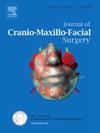使用计算机辅助技术重建髂深周动脉皮瓣的布朗Ⅱ级和Ⅲ级缺损的通用程序。
IF 2.1
2区 医学
Q2 DENTISTRY, ORAL SURGERY & MEDICINE
引用次数: 0
摘要
目的:本研究总结分析了髂周深动脉(DCIA)皮瓣重建上颌骨缺损的特点,并提出了在计算机辅助技术指导下提高手术效率和成功率的通用方案:回顾性分析了10例在计算机辅助技术应用下使用DCIA皮瓣重建的上颌骨缺损病例,收集临床数据进行统计分析:这些病例包括2例囊性病变、2例黏液瘤、2例釉母细胞瘤、1例黏液表皮样癌、1例牙源性纤维瘤、1例鳞状细胞癌(SCC)术后骨缺损和1例骨化性纤维瘤。根据布朗分类系统,共有 7 例 IIb 型缺损、1 例 IId 型缺损、1 例 IIIb 型缺损和 1 例 IIId 型缺损。采集的髂骨长度从 42 毫米到 100 毫米不等,宽度从 20 毫米到 51 毫米不等。7名患者使用了嵌合髂肌筋膜瓣;2名患者使用了髂周深动脉穿孔器(DCIAP)瓣;1名患者使用了血管化髂嵴。所有病例的受体血管均为面部动脉和静脉。4例进行了口内吻合,6例进行了颌下吻合。8 例患者的供体部位选自同侧髂骨,2 例患者的供体部位选自对侧髂骨。平均手术时间为 8.74 小时。术后,9 名患者恢复良好,未出现任何并发症,1 名患者在术后第一天出现骨瓣坏死,需要使用血管化腓骨瓣进行二次重建。术后平均住院时间为 8.6 天:结论:DCIA 骨瓣与计算机辅助技术的结合为上颌骨缺损的重建和功能恢复提供了一种可靠的方法。建立通用程序可促进其更广泛的应用。本文章由计算机程序翻译,如有差异,请以英文原文为准。
A generalizable procedure for Brown's class Ⅱ and Ⅲ defects reconstruction with deep circumflex iliac artery flap using computer-assisted technique
Objective
This study summarizes and analyzes the characteristics of deep circumflex iliac artery (DCIA) flap reconstruction for maxillary defects and proposes a generalized protocol under the guidance of computer-assisted technique to enhance surgical efficiency and success rate.
Materials and methods
We retrospectively reviewed 10 cases of maxillary defects reconstructed using DCIA flaps under the application of computer-assisted technique, collecting clinical data for statistical analysis.
Results
These cases included 2 cystic lesions, 2 mucinous tumors, 2 ameloblastomas, 1 mucoepidermoid carcinoma, 1 odontogenic fibroma, 1 bone defect following squamous cell carcinoma (SCC) surgery, and 1 ossifying fibroma. According to Brown's classification system, there were 7 Type IIb defects, 1 Type IId defect, 1 Type IIIb defect, and 1 Type IIId defect. The length of the iliac bone harvested ranged from 42 mm to 100 mm, and the width from 20 mm to 51 mm. In 7 patients, chimeric iliac myofascial flaps were used; in 2 patients, deep circumflex iliac artery perforator (DCIAP) flaps were utilized; and in 1 patient, a vascularized iliac crest was employed. The recipient vessels were the facial artery and vein in all cases. Intraoral anastomoses were performed in 4 cases, and submandibular anastomoses in 6 cases. The donor site was chosen from the ipsilateral ilium in 8 patients and from the contralateral ilium in 2 patients. The mean operative time was 8.74 hours. Postoperatively, 9 patients recovered well without any complications, while 1 patient experienced necrosis of the bone flap on the first day after surgery and underwent secondary reconstruction using a vascularized fibula flap. The average postoperative hospital stay was 8.6 days.
Conclusion
The combination of DCIA flaps with computer-assisted technique provides a reliable method for the reconstruction of maxillary defects and functional restoration. Establishing generalized procedures could facilitate its broader application.
求助全文
通过发布文献求助,成功后即可免费获取论文全文。
去求助
来源期刊
CiteScore
5.20
自引率
22.60%
发文量
117
审稿时长
70 days
期刊介绍:
The Journal of Cranio-Maxillofacial Surgery publishes articles covering all aspects of surgery of the head, face and jaw. Specific topics covered recently have included:
• Distraction osteogenesis
• Synthetic bone substitutes
• Fibroblast growth factors
• Fetal wound healing
• Skull base surgery
• Computer-assisted surgery
• Vascularized bone grafts

 求助内容:
求助内容: 应助结果提醒方式:
应助结果提醒方式:


